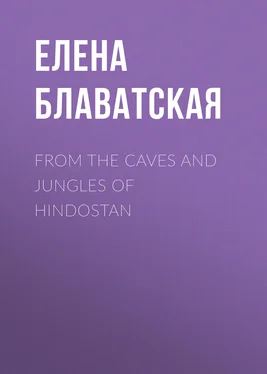Елена Блаватская - From the Caves and Jungles of Hindostan
Здесь есть возможность читать онлайн «Елена Блаватская - From the Caves and Jungles of Hindostan» — ознакомительный отрывок электронной книги совершенно бесплатно, а после прочтения отрывка купить полную версию. В некоторых случаях можно слушать аудио, скачать через торрент в формате fb2 и присутствует краткое содержание. Жанр: Путешествия и география, История, foreign_edu, foreign_antique, foreign_prose, на английском языке. Описание произведения, (предисловие) а так же отзывы посетителей доступны на портале библиотеки ЛибКат.
- Название:From the Caves and Jungles of Hindostan
- Автор:
- Жанр:
- Год:неизвестен
- ISBN:нет данных
- Рейтинг книги:5 / 5. Голосов: 1
-
Избранное:Добавить в избранное
- Отзывы:
-
Ваша оценка:
- 100
- 1
- 2
- 3
- 4
- 5
From the Caves and Jungles of Hindostan: краткое содержание, описание и аннотация
Предлагаем к чтению аннотацию, описание, краткое содержание или предисловие (зависит от того, что написал сам автор книги «From the Caves and Jungles of Hindostan»). Если вы не нашли необходимую информацию о книге — напишите в комментариях, мы постараемся отыскать её.
From the Caves and Jungles of Hindostan — читать онлайн ознакомительный отрывок
Ниже представлен текст книги, разбитый по страницам. Система сохранения места последней прочитанной страницы, позволяет с удобством читать онлайн бесплатно книгу «From the Caves and Jungles of Hindostan», без необходимости каждый раз заново искать на чём Вы остановились. Поставьте закладку, и сможете в любой момент перейти на страницу, на которой закончили чтение.
Интервал:
Закладка:
That is the question. If Fergusson, being bound by facts existing in inscriptions to acknowledge the antiquity of Karli, will still persist in asserting that Elephanta is of much later date, he will scarcely be able to solve this dilemma, because the two styles are exactly the same, and the carvings of the latter are still more magnificent. To ascribe the temples of Elephanta and Kanari to the Buddhists, and to say that their respective periods correspond to the fourth and fifth centuries in the first case, and the tenth in the second, is to introduce into history a very strange and unfounded anachronism. After the first century A.D. there was not left a single influential Buddhist in India. Conquered and persecuted by the Brahmans, they emigrated by thousands to Ceylon and the trans-Himalayan districts. After the death of King Asoka, Buddhism speedily broke down, and in a short time was entirely displaced by the theocratic Brahmanism.
Fergusson's hypothesis that the followers of Sakya Sing, driven out by intolerance from the continent, probably sought shelter on the islands that surround Bombay, would hardly sustain critical analysis. Elephanta and Salsetta are quite near to Bombay, two and five miles distant respectively, and they are full of ancient Hindu temples. Is it credible, then, that the Brahmans, at the culminating point of their power, just before the Mussulman invasions, fanatical as they were, and mortal enemies of the Buddhists, would allow these hated heretics to build temples within their possessions in general and on Gharipuri in particular, this latter being an island consecrated to their Hindu pagodas? It is not necessary to be either a specialist, an architect, or an eminent archeologist, in order to be convinced at the first glance that such temples as Elephanta are the work of Cyclopses, requiring centuries and not years for their construction. Whereas in Karli everything is built and carved after a perfect plan, in Elephanta it seems as if thousands of different hands had wrought at different times, each following its own ideas and fashioning after its own device. All three caves are dug out of a hard porphyry rock. The first temple is practically a square, 130 feet 6 inches long and 130 feet wide. It contains twenty-six thick pillars and sixteen pilasters.
Between some of them there is a distance of 12 or 16 feet, between others 15 feet 5 inches, 13 feet 3 1/2 inches, and so on. The same lack of uniformity is found in the pedestals of the columns, the finish and style of which is constantly varying.
Why, then, should we not pay some attention to the explanations of the Brahmans? They say that this temple was begun by the sons of Pandu, after "the great war," Mahabharata, and that after their death every true believer was bidden to continue the work according to his own notions. Thus the temple was gradually built during three centuries. Every one who wished to redeem his sins would bring his chisel and set to work. Many were the members of royal families, and even kings, who personally took part in these labors.
On the right hand side of the temple there is a corner stone, a lingam of Shiva in his character of Fructifying Force, which is sheltered by a small square chapel with four doors. Round this chapel are many colossal human figures. According to the Brahmans, these are statues representing the royal sculptors themselves, they being doorkeepers of the holy of holies, Hindus of the highest caste. Each of the larger figures leans upon a dwarf representative of the lower castes, which have been promoted by the popular fancy to the rank of demons (Pisachas). Moreover, the temple is full of unskillful work. The Brahmans hold that such a holy place could not be deserted if men of the preceding and present generations had not become unworthy of visiting it. As to Kanari or Kanhari, and some other cave temples, there is not the slightest doubt that they were all erected by Buddhists. In some of them were found inscriptions in a perfect state of preservation, and their style does not remind one in the least of the symbolical buildings of the Brahmans. Archbishop Heber thinks the Kanari caves were built in the first or second centuries B.C. But Elephanta is much older and must be classed among prehistoric monuments, that is to say, its date must be assigned to the epoch that immediately followed the "great war," Mahabharata. Unfortunately the date of this war is a point of disagreement between European scientists; the celebrated and learned Dr. Martin Haug thinks it is almost antediluvian, while the no less celebrated and learned Professor Max Muller places it as near the first century of our era as possible.
The fair was at its culmination when, having finished visiting the cells, climbing over all the stories, and examining the celebrated "hall of wrestlers," we descended, not by way of the stairs, of which there is no trace to be found, but after the fashion of pails bringing water out of a deep well, that is to say, by the aid of ropes. A crowd of about three thousand persons had assembled from the surrounding villages and towns. Women were there adorned from the waist down in brilliant-hued saris, with rings in their noses, their ears, their lips, and on all parts of their limbs that could hold a ring. Their raven-black hair which was smoothly combed back, shone with cocoanut oil, and was adorned with crimson flowers, which are sacred to Shiva and to Bhavani, the feminine aspect of this god.
Before the temple there were rows of small shops and of tents, where could be bought all the requisites for the usual sacrifices—aromatic herbs, incense, sandal wood, rice, gulab, and the red powder with which the pilgrim sprinkles first the idol and then his own face. Fakirs, bairagis, hosseins, the whole body of the mendicant brotherhood, was present among the crowd. Wreathed in chaplets, with long uncombed hair twisted at the top of the head into a regular chignon, and with bearded faces, they presented a very funny likeness to naked apes. Some of them were covered with wounds and bruises due to mortification of the flesh. We also saw some bunis, snake-charmers, with dozens of various snakes round their waists, necks, arms, and legs—models well worthy of the brush of a painter who intended to depict the image of a male Fury. One jadugar was especially remarkable. His head was crowned with a turban of cobras. Expanding their hoods and raising their leaf-like dark green heads, these cobras hissed furiously and so loudly that the sound was audible a hundred paces off. Their "stings" quivered like lightning, and their small eyes glittered with anger at the approach of every passer-by. The expression, "the sting of a snake," is universal, but it does not describe accurately the process of inflicting a wound. The "sting" of a snake is perfectly harmless. To introduce the poison into the blood of a man, or of an animal, the snake must pierce the flesh with its fangs, not prick with its sting. The needle-like eye teeth of a cobra communicate with the poison gland, and if this gland is cut out the cobra will not live more than two days. Accordingly, the supposition of some sceptics, that the bunis cut out this gland, is quite unfounded. The term "hissing" is also inaccurate when applied to cobras. They do not hiss. The noise they make is exactly like the death-rattle of a dying man. The whole body of a cobra is shaken by this loud and heavy growl.
Here we happened to be the witnesses of a fact which I relate exactly as it occurred, without indulging in explanations or hypotheses of any kind. I leave to naturalists the solution of the enigma.
Expecting to be well paid, the cobra-turbaned buni sent us word by a messenger boy that he would like very much to exhibit his powers of snake-charming. Of course we were perfectly willing, but on condition that between us and his pupils there should be what Mr. Disraeli would call a "scientific frontier." 2 2 Written in 1879.
We selected a spot about fifteen paces from the magic circle. I will not describe minutely the tricks and wonders that we saw, but will proceed at once to the main fact. With the aid of a vaguda, a kind of musical pipe of bamboo, the buni caused all the snakes to fall into a sort of cataleptic sleep. The melody that he played, monotonous, low, and original to the last degree, nearly sent us to sleep ourselves. At all events we all grew extremely sleepy without any apparent cause. We were aroused from this half lethargy by our friend Gulab-Sing, who gathered a handful of a grass, perfectly unknown to us, and advised us to rub our temples and eyelids with it. Then the buni produced from a dirty bag a kind of round stone, something like a fish's eye, or an onyx with a white spot in the centre, not bigger than a ten-kopek bit. He declared that anyone who bought that stone would be able to charm any cobra (it would produce no effect on snakes of other kinds) paralyzing the creature and then causing it to fall asleep. Moreover, by his account, this stone is the only remedy for the bite of a cobra. You have only to place this talisman on the wound, where it will stick so firmly that it cannot be torn off until all the poison is absorbed into it, when it will fall off of itself, and all danger will be past.
Интервал:
Закладка:
Похожие книги на «From the Caves and Jungles of Hindostan»
Представляем Вашему вниманию похожие книги на «From the Caves and Jungles of Hindostan» списком для выбора. Мы отобрали схожую по названию и смыслу литературу в надежде предоставить читателям больше вариантов отыскать новые, интересные, ещё непрочитанные произведения.
Обсуждение, отзывы о книге «From the Caves and Jungles of Hindostan» и просто собственные мнения читателей. Оставьте ваши комментарии, напишите, что Вы думаете о произведении, его смысле или главных героях. Укажите что конкретно понравилось, а что нет, и почему Вы так считаете.












